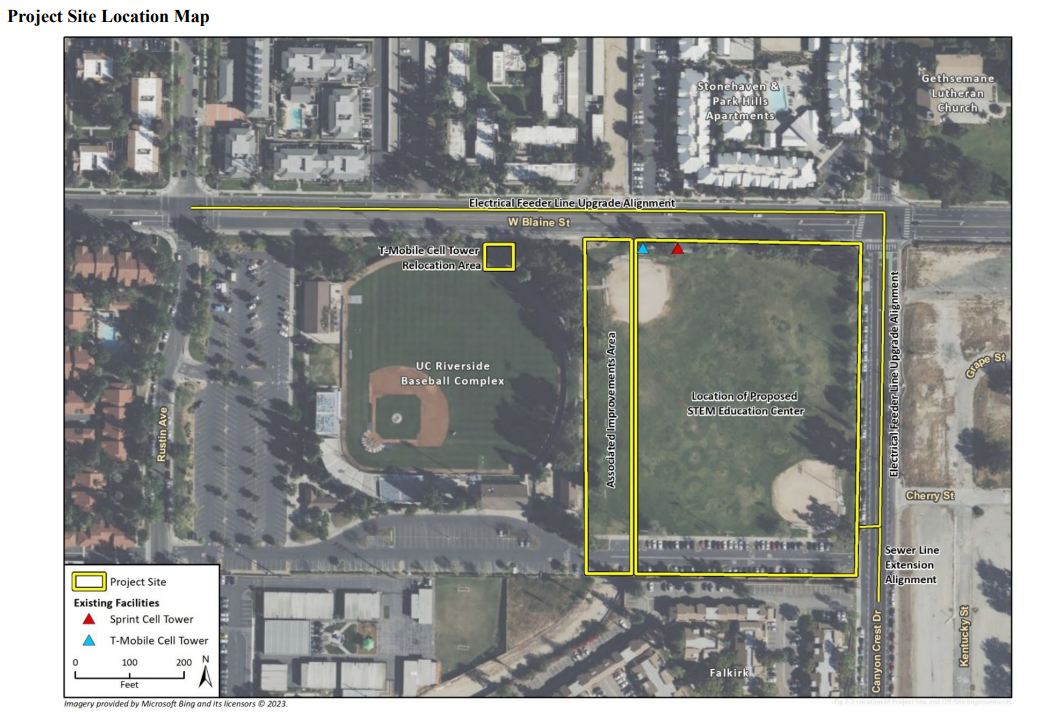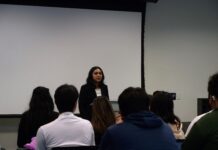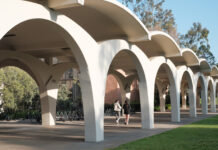The University of California, Riverside (UCR) has released its Draft Environmental Impact Report (EIR) on the Riverside Unified School District (RUSD) Science, Technology, Engineering, and Mathematics (STEM) Education Center. The partnership of UCR and RUSD includes a ground lease to RUSD to build an 80,000 sq. ft, three-story, RUSD STEM Education Center, previously called the RUSD STEM High School. The new building will be a STEM-centered high school, supporting 9th through 12th grade students on UCR soil, and is projected to host about 1,200 students and 60 faculty personnel daily. The students who will be in attendance are supposed to be pursuing interests in areas of STEM.
The proposed center is to be built next to the UC Riverside Baseball Complex on the corner of W. Blaine Street and Canyon Crest Drive. The Center would be built with a 153-space surface parking lot, bus drop-off zone, a robotics testing area, garden beds, lunch and outdoor seating areas in addition to the new building
The public review and hearing of the Draft EIR took place on Tuesday, April 17, 2024, at the Courtyard by Marriott located on University Avenue. During the hearing, Stephanie Tang, Environmental Planner of UCR, welcomed the faculty of both UCR and RUSD, such as the UCR Vice Chancellor of Planning, Budget and Administration, Gerry Bomotti, RUSD Board President, Dale Kinnear and and Board Clerk, Dr. Noemi Hernandez Alexander.
After members of the RUSD faculty introduced the project’s objectives, it was stated that construction would possibly take place by 2027. However, the date depends on the Division of the State Architect (DSA) approval and available funding. Environmental consultant, Annaliese Torres, gave an overview of the EIR and concluded that the RUSD STEM Education Center would have a minimal negative impact on the community and environment with proper mitigation measures in place.
Following the overview of the draft, a quick summary of project alternatives was presented. Then, the floor was open to the public for concerns or endorsements of the project. There were over 15 members of the community, teachers, professors, students and homeowners, who shared their thoughts on the project.

The number one concern amongst the participants was the issue of parking. Many in opposition to the project claimed it had inadequate parking measures, such as minimal parking spaces and lack of overflow spaces. There are also worries about increased traffic. The first speaker referenced this issue by pointing out that the study the EIR cited to claim that traffic would not be an issue was not taken at peak hours. Another person added to his statement that the study was taken during COVID-19 when UCR students were also not in attendance at the school. Thus, many people felt it was a misrepresentation of the heavy traffic that occurs during commuting hours.
The last speaker, UCR alumni, and former ASUCR President Aram Ayra voiced UCR student concerns. He pointed out the “impact it will have on UCR students, the people who are being charged up to 30,000 dollars a year to attend,” explaining that UCR’s student body government has been fighting this project for six academic years across the changing student government representatives. “For the majority of UCR students, it will create increased competition for already limited resources … Adding 1,200 students and their families would exacerbate [resources] with no clear mitigation efforts presented.”
Ayra also claimed that there is a “false dichotomy” being presented: one either supports the project and thus supports STEM education, or one does not support STEM education because one does support the project. He clarifies that “many UCR students support education and want to be good community partners, but not at the cost of their higher education, their access to campus resources, and their ability to utilize facilities that they, and their parents, annually pay an exorbitant amount of money for.”
Another student brought his perspective in as an athlete. President of UCR Club Baseball, Johnkeith Wong, shared that they use the fields the Center would be built on for practice 2 to 6 times a week. He spoke on behalf of his club, Club Rugby, and The Ultimate Frisbee Team. He stated, “I am grateful to the competitive sports department for letting us use the facility. And, the disruption of the fields leads to no opportunities to practice.” He also shared that his team is in the running for the national championship and playoff spot in the league; therefore, his team is practicing often and using the space often. He mentioned that changing practice locations could be an added cost to his members which the club is not well-prepared to take responsibility for.
A student who was in favor of the bill was a third-year engineering student, Michael Tin, who was well involved with high school school-centered organizations such as the Riverside STEM Academy Foundation. He argues that the Center has the “potential to make a difference in many kids’ lives.” He is not the only one who expressed this sentiment. Many of those in favor including teachers, professors, members of the PTA, and others, expressed that the school would help incoming high schoolers be more college-ready.
Nevertheless, the concerns of the public will be addressed after the public review period, which ends on May 2, 2024. Any concerns or comments can still be received and taken into consideration by emailing ceqa@ucr.edu with the following information: your name, address, phone number and email address, and include as the subject: STEM Education Center EIR. All comments should be submitted by May 2, 2024, at 5 p.m. Once the Final EIR is prepared with the necessary responses to the comments UCR will be given time to publish the document.
Additional information can be found at the STEM Education Center website, the Environmental Planning CEQA website, the presented slide deck, or the recording of the hearing.






